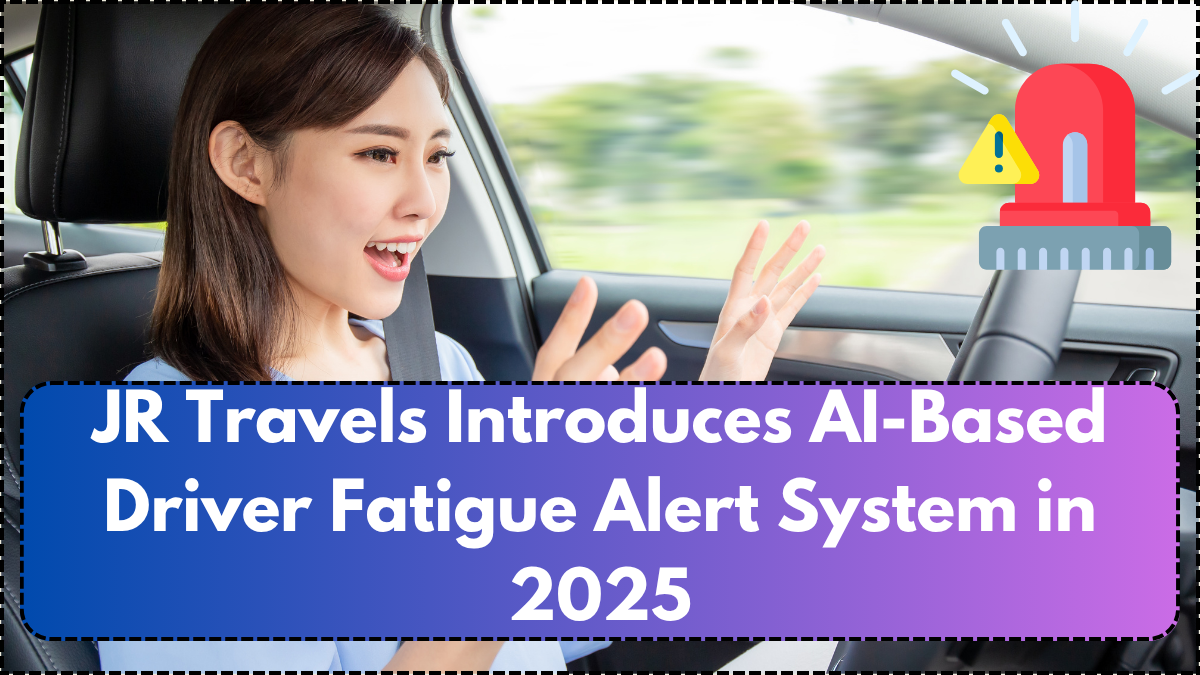In a forward-looking move aimed at boosting long-distance travel safety, JR Travels has begun deploying driver fatigue monitoring tech across its fleet of intercity buses as of July 2025. With road accidents often attributed to drowsy or inattentive driving during long hauls, the company is now integrating artificial intelligence (AI) to monitor driver alertness in real-time.
This cutting-edge fatigue alert system uses facial recognition, eye tracking, and behavior analysis to detect early signs of fatigue, micro-sleeps, or distraction. Alerts are instantly triggered to both the driver and the control room, allowing timely action to avoid potential accidents.

Why Fatigue Monitoring is Crucial for Long-Distance Travel Safety
Driver fatigue has remained a leading cause of road accidents, especially on overnight or cross-province journeys. The new driver fatigue monitoring tech is not just a smart solution—it’s a critical safety intervention aligned with national transport safety goals.
Key reasons for adopting this technology include:
-
Drowsy driving accounts for up to 18% of heavy vehicle accidents in South Africa
-
Long-distance buses often operate in low-visibility or overnight conditions
-
Traditional rest schedules are often irregular or poorly managed
-
Enhanced passenger confidence in JR Travels’ safety practices
-
Alignment with upcoming South African road safety digitalization standards
The system works even in low-light conditions and is unaffected by sunglasses or external lighting, offering reliable performance at all times.
Features of the Driver Fatigue Monitoring Tech
JR Travels has partnered with a tech start-up specializing in AI-based safety systems to implement its monitoring equipment. The installation is being rolled out phase-wise, starting with long-haul routes like Johannesburg to Cape Town and Durban to Pretoria.
Below is a table of the system’s technical capabilities:
| Feature | Description |
|---|---|
| Eye Movement Analysis | Tracks blink rate, gaze direction, and eyelid closure |
| Facial Expression Recognition | Detects yawning, head tilts, and drooping posture |
| Real-Time Alerts | Sends audio-visual signals and control room notifications |
| Integration with Vehicle Systems | Slows vehicle automatically in critical fatigue moments |
| Night-Time Functionality | Infrared cameras for low-light fatigue tracking |
| Cloud-Based Data Logging | Maintains driving behavior history for review |
With this system, safety supervisors can proactively intervene even before a dangerous situation escalates.
Deployment Timeline and Route Prioritization
In July 2025, JR Travels began outfitting its high-mileage buses with the driver fatigue monitoring tech. By the end of September, the company aims to complete installation on all night-route and intercity vehicles, with regional services to follow in Q4.
Routes selected for Phase 1:
-
Johannesburg – Cape Town
-
Durban – Pretoria
-
Bloemfontein – Port Elizabeth
-
East London – Kimberley
-
Nelspruit – Johannesburg (via Kruger routes)
Additionally, every driver undergoes training on interpreting system alerts and using fatigue control measures such as breaks, hydration, and seat posture.
Safety Outcomes and Customer Impact
The deployment of AI-driven fatigue detection is expected to significantly enhance long-distance travel safety. JR Travels anticipates a 40% reduction in driver-related safety incidents across its fleet within six months of full implementation.
Customer benefits include:
-
Safer rides with less risk of driver error
-
Better adherence to rest-stop schedules
-
Peace of mind for overnight travelers
-
Real-time control room oversight of each trip
This proactive step reaffirms JR Travels’ leadership in embracing technology for public safety and reliability.
Conclusion
By investing in driver fatigue monitoring tech, JR Travels is pioneering a safer future for South Africa’s intercity transport sector. Aligned with national goals for long-distance travel safety, this AI-enhanced system not only protects passengers and drivers but also sets a new standard for responsible travel. With implementation already in motion this July 2025, other fleet operators may soon follow suit in adopting this life-saving innovation.
FAQs
What is driver fatigue monitoring tech?
It’s an AI-powered system that detects signs of drowsiness or distraction in drivers using facial recognition and eye tracking.
Why is this technology important for long-distance travel safety?
Because fatigue is a leading cause of road accidents, especially on overnight and intercity routes, this tech can prevent crashes before they happen.
Which routes will first have this system installed?
Major routes like Johannesburg to Cape Town and Durban to Pretoria are among the first to receive the system.
Does the system take any action when fatigue is detected?
Yes, it sends alerts to both the driver and a control room, and in critical cases, can initiate automatic slowing of the vehicle.
Will passengers notice the system during travel?
No, it operates discreetly via dashboard-mounted cameras and does not interfere with the driving or passenger experience.
Click here to learn more